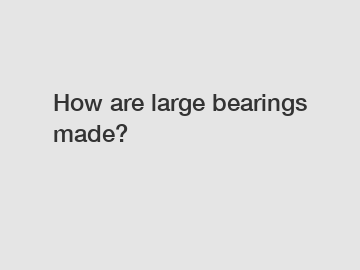How are large bearings made?
How Are Large Bearings Made? An In-depth Look at the Manufacturing Process.
Large bearings play a crucial role in numerous industrial applications, from wind turbines to heavy machinery. These vital components enable smooth rotational movement and support heavy loads. But have you ever wondered how these large bearings are made? In this article, we will delve into the manufacturing process of large bearings, exploring the various steps involved and the materials used.
1. The Importance of Large Bearings.

Large bearings are essential for critical applications that involve heavy loads and high rotational speeds. They are commonly used in industries such as aerospace, energy, automotive, and manufacturing. Without the proper design and manufacturing techniques, bearings would be prone to failure, leading to downtime, increased maintenance costs, and even safety risks. Therefore, understanding the manufacturing process is crucial for ensuring the production of high-quality, durable bearings.
2. Material Selection.
The first step in manufacturing large bearings is selecting the appropriate material. Bearings are usually made from high-quality steel, such as chrome steel or stainless steel. These materials offer excellent strength, durability, and resistance to wear and corrosion. The steel is carefully analyzed for composition and quality to ensure it meets the required standards.
3. Forging.
The selected steel is then subjected to a forging process to shape it into a rough bearing ring. Forging involves applying high pressure and heat to the steel, which modifies its grain structure, resulting in improved mechanical properties. The process ensures that the bearings can withstand heavy loads and maintain their integrity under extreme conditions.
4. Turning and Grinding.
Once the forging process is complete, the rough bearing rings undergo further machining operations, such as turning and grinding. Turning involves removing excess material and achieving specific dimensional accuracy. The rings are rotated against a cutting tool, which shapes them into their desired dimensions. Grinding is then employed to achieve a smoother, more precise surface finish, ensuring the bearings' optimal performance.
5. Heat Treatment.
Heat treatment is a critical step in the manufacturing process of large bearings, as it enhances their mechanical properties. The rings are subjected to controlled heating and cooling processes to modify their hardness, strength, and toughness. This step is essential to ensure that the bearings have the necessary load-carrying capacity and resistance to wear and fatigue.
6. Assembly.
After the rings have been heat-treated, they are ready for assembly. The inner and outer rings, along with the rolling elements (balls or rollers), are precisely fitted together. The component assembly is performed with utmost care and accuracy, as any misalignment or improper fit could affect the bearing's performance. Advanced machinery and techniques are employed to ensure the correct alignment and clearance.
7. Lubrication.
Lubrication is crucial for reducing friction and preventing wear in large bearings. Depending on the application, different types of lubricants, such as oil or grease, are used. The lubricants are carefully selected based on factors like temperature, speed, and load capacity. Proper lubrication not only extends the life of the bearing but also reduces energy consumption and enhances overall efficiency.
8. Quality Control.
Before large bearings are shipped to customers, they undergo rigorous quality control procedures. Various tests, including dimensional inspection, material analysis, and performance testing, are conducted to ensure the bearings meet the required specifications. Inspecting the bearings' surface finish, raceway geometry, and noise levels is essential to guarantee their smooth operation and reliability.
In conclusion, the manufacturing process of large bearings involves several crucial steps, from material selection to quality control. Each stage requires precision, expertise, and strict adherence to standards to produce bearings capable of withstanding heavy loads, high rotational speeds, and demanding environments. By understanding the intricate process behind large bearing production, we can appreciate the complexity involved in manufacturing these crucial components that fuel industries worldwide.
The company is the world’s best China Top Quality Bearing, Matched Single Row Tapered Roller Bearings, Double-Row Cylindrical Roller Bearings for Steel Plant Gearboxes supplier. We are your one-stop shop for all needs. Our staff are highly-specialized and will help you find the product you need.

Comments